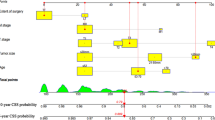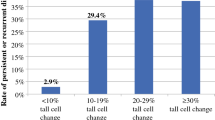Abstract
Background
In the 1980s, histology of a poorly differentiated carcinoma showing an aggressive behavior was proposed by Sakamoto et al. and other pathologists. This was adopted as an independent entity by the World Health Organization (WHO) and in the General Rules for the Description of Thyroid Cancer by The Japanese Society of Thyroid Surgery (JSTS). Furthermore, the Turin classification was recently proposed as the newest classification system for poorly differentiated carcinoma. Furthermore, although tall cell variant is not included in poorly differentiated carcinoma, it is thought to show aggressive characteristics. In this study, we investigated the prevalence and clinical significance of three types of poorly differentiated carcinoma defined by the WHO classification system (poorly differentiated carcinoma [WHO]), Turin proposal (poorly differentiated carcinoma [Turin]), and JSTS (poorly differentiated carcinoma [Sakamoto]), and tall cell variant in papillary carcinoma.
Methods
We investigated the prevalence and prognostic significance of these three histological types in 1707 papillary carcinomas.
Results
In our series, 189 (11.1%), 15 (0.8%), 5 (0.3%), and 62 (3.6%) patients were diagnosed as having poorly differentiated carcinoma (Sakamoto), poorly differentiated carcinoma (WHO), poorly differentiated carcinoma (Turin), and tall cell variant, respectively. Poorly differentiated carcinoma (WHO) and tall cell variant independently affected cause-specific survival (CSS) of patients, but poorly differentiated carcinoma (Sakamoto) predicted only worse disease-free survival (DFS) of patients on multivariate analysis. Poorly differentiated carcinoma (Turin) showed the worst DFS and CSS rates of patients but was not confirmed as an independent prognostic factor probably because of the small number of patients.
Conclusions
Poorly differentiated carcinoma (WHO) and tall cell variant significantly affected patient prognosis. Poorly differentiated carcinoma (Turin) accounts only for 0.3% but showed the worst survival rates. Although poorly differentiated carcinoma (Sakamoto) predicted the likelihood of carcinoma recurrence, it is more appropriate to define this lesion as one of the histological subtypes of papillary carcinoma rather than as an independent histological entity.



Similar content being viewed by others
References
Sobin LH, Wittekind Ch (eds) (2002) UICC: TNM classification of malignant tumors, 6th ed. Wiley-Liss, New York
Ito Y, Miyauchi A, Jikuzono T, Higashiyama T, Takamura T, Miya A, Kobayashi K, Matsuzuka F, Ichihara K, Kuma K (2007) Risk factors contributing to a poor prognosis of papillary thyroid carcinoma; Validity of UICC/AJCC TNM classification and stage grouping. World J Surg 31:838–848
Ito Y, Hirokawa M, Jikuzono T, Higashiyama T, Takamura Y, Miya A, Kobayashi K, Matsuzuka F, Kuma K, Miyauchi A (2007) Extranodal tumor extension to adjacent organs predicts a worse cause-specific survival in patients with papillary thyroid carcinoma. World J Surg 31:1196–1203
Sakamoto A, Kasai N, Sugano H (1983) Poorly differentiated carcinoma of the thyroid. A clinicopathologic entity for a high risk group of papillary and follicular carcinomas. Cancer 52:1849–1855
Carcangiu ML, Zampi G, Rosai J (1984) Poorly differentiated (“insular”) thyroid carcinoma. A reinterpretation of Langhans’ “Wuchernde Struma.” Am J Surg Pathol 8:655–668
Nishiyama RH (1999) Another dissertation on poorly differentiated carcinomas: is it really necessary? Adv Anat Pathol 6:281–286
Rosai J (2004) Poorly differentiated thyroid carcinoima: introduction to the issue, its landmarks, and clinical impact. Endocr Pathol 15:293–296
Sakamoto A (2004) Definition of poorly differentiated carcinoma of the thyroid: the Japanese experience. Endocr Pathol 15:307–311
Sobrinho-Simoes M (1996) Poorly differentiated thyroid carcinomas. Endocr Pathol 2:99–102
Volante M, Landolfi S, Chiusa L, et al. (2004) Poorly differentiated carcinoma of the thyroid with trabecular, insular, and solid patterns: a clinicopathologic study of 183 patients. Cancer 100:950–957
Aklen LA, LiVolsi VA (2000) Poorly differentiated thyroid carcinoma – it is important. Am J Surg Pathol 24:310–313
Nishida T, Katayama S, Tsujimoto M, Nakamura J, Matsuda H (1999) Clinicopathological significance of poorly differentiated thyroid carcinoma. Am J Surg Pathol 23:205–211
Wreesman V, Rhossein R (2002) Genome-wide appraisal of thyroid cancer progression. Am J Pathol 161:1549–1556
Hiltizik D, Carlson DL, Tuttle RM, et al. (2006) Poorly differentiated thyroid carcinomas defined on the basis of mitosis and necrosis. A clnicopathological study of 58 patients. Cancer 106:1286–1295
Sobrinho-Simoes M, Carcangiu ML, Albores-Saavedra J, et al. (2004) Poorly differentiated carcinoma. In: DeLeillis RA, Lloyd RV, Heitz PU, et al. (eds) Pathology and genetics of tumous of endocrine organs. IARC Press, Lyon, pp 73–76
Valante M, Collini P, Nikiforov EY, et al. (2007) Poorly differentiated thyroid carcinoma: the Turin proposal for the use of uniform diagnostic criteria and an algorhthmic diagnostic approach. Am J Surg Pathol 31:1256–1264
The Japanese Society of Thyroid Surgery (2005) General rules for the description of thyroid cancer, 6th edn. Kanehara Press, Tokyo
Hawk WA, Hazard JB (1976) The many appearances of ppapillary carcinoma of the thyroid. Clevel Clin Q 43:207–215
Johnson TL, Lloyd RV, Thompson NW, Beierwaltes WH, Sisson JC (1988) Prognostic implications of the tall cell variant of papillary thyroid carcinoma. Am J Surg Pathol 12:22–27
Egea AM, Gonzales JMR, Perez JS, Cogollos TS, Paricio PP (1993) Prognostic value of the tall cell variety of papillary cancer of the thyroid. Eur J Surg Oncol 19:517–521
Michels JJ, Jacques M, Henry-Amar M, Bardet S (2007) Prevalence and prognostic significance of tall cell variant of papillary thyroid carcinoma. Human Pathol 38:212–219
Sanders EM, LiVolsi VA, Brierley J, et al. (2007) An evidence-based review of poorly differentiated thyroid cancer. World J Surg 31:934–945
Akslen LA, LiVolsi VA (2000) Prognostic significance of histologic grading compared with subclassification of papillary thyroid carcinoma. Cancer 88:1902–1908
Author information
Authors and Affiliations
Corresponding author
Rights and permissions
About this article
Cite this article
Ito, Y., Hirokawa, M., Fukushima, M. et al. Prevalence and Prognostic Significance of Poor Differentiation and Tall Cell Variant in Papillary Carcinoma in Japan. World J Surg 32, 1535–1543 (2008). https://doi.org/10.1007/s00268-007-9406-7
Published:
Issue Date:
DOI: https://doi.org/10.1007/s00268-007-9406-7




